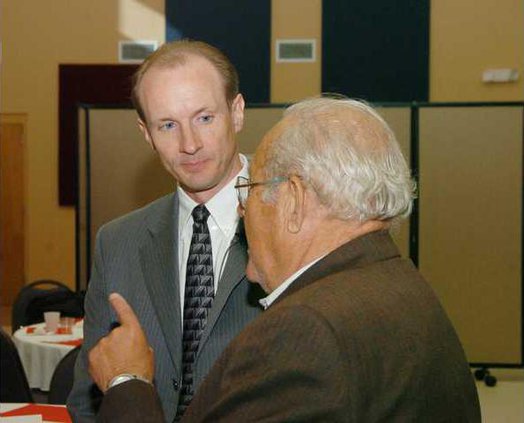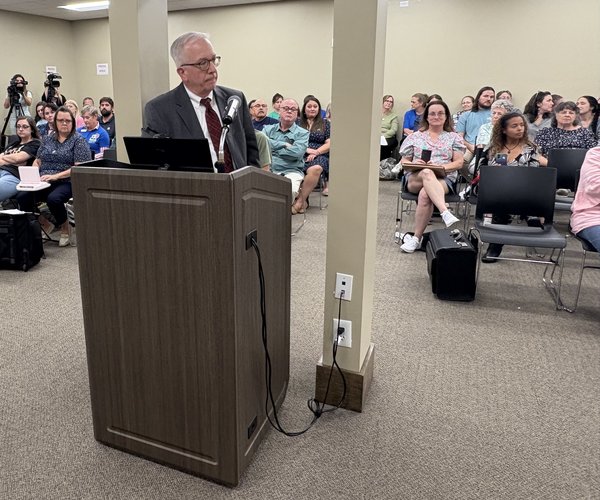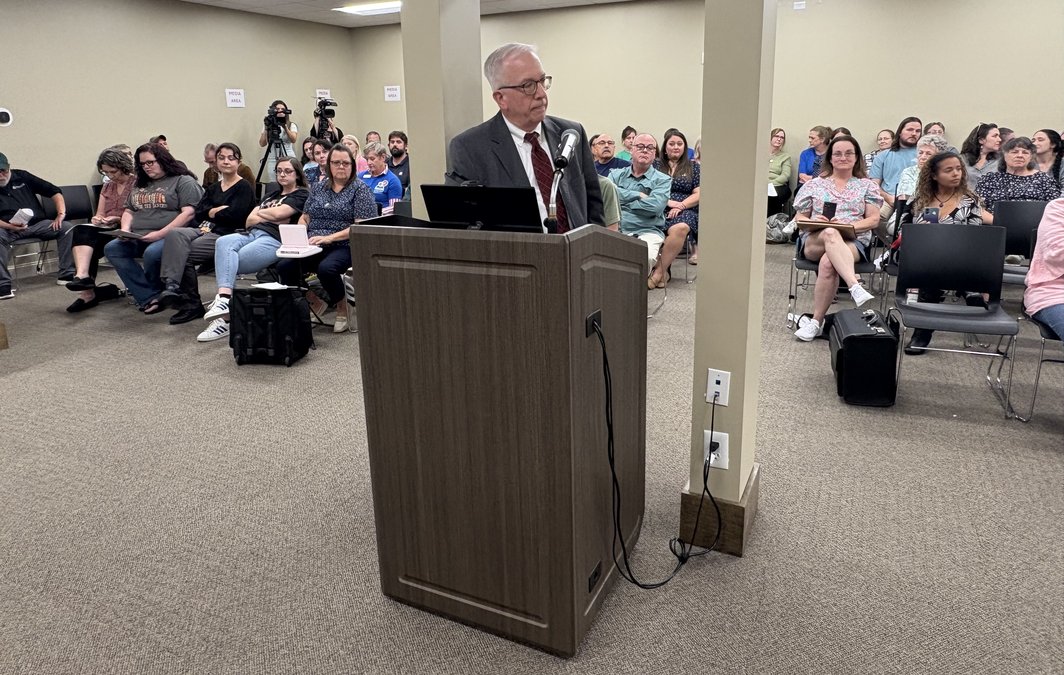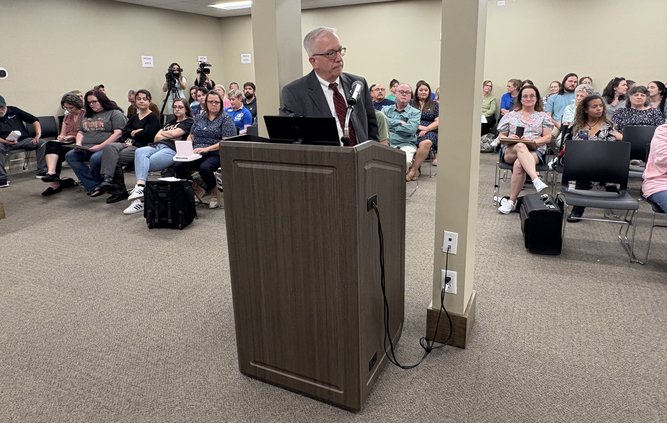The economic picture is gloomy but it isn’t as dire as widely thought, Effingham Chamber of Commerce members learned Wednesday morning.
Dr. Michael Toma, director of the Center of Regional Analysis at Armstrong Atlantic State University, said the nation is not in a great depression. In fact, it’s not even close to that point, he said.
“I think it’s misinformation. I think it’s disinformation,” Toma said. “It’s fear-mongering. We’re not in the ‘great depression of 2009.’ It’s nowhere near that. It’s an exaggeration.
“It’s inappropriate. It’s wrong. It’s incorrect.”
But the constant harping of how bad things are has led to consumer confidence sapping, Toma added.
“There’s always been business cycles,” he said. “We haven’t gotten to the point where we make those cycles go away. This is a little more severe than what we have seen in several years. We got used to small, mild recessions. We got a false sense of security.”
Effingham’s economy has been holding steady, even with the slide in the housing market, Toma said.
“Halfway into the downturn, Effingham County had been holding up well,” he said. “In terms of the stock market, Effingham County was an outperforming stock.”
The number of businesses had grown to 765 in 2008, up from 741 in 2007, and the number of employed workers grew from 9,703 to 9,760. Most of that growth came in manufacturing, which has helped offset the losses in other sectors.
Toma also pointed out that adding manufacturing jobs also aids the economy in other ways — since manufacturing jobs pay more and that means they have more money to spend.
“The economic payoff is higher,” he said.
Effingham’s population is still growing, though not at the pace of a few years ago. In 2005, the county’s population grew by 5 percent and it was up by 2.5 percent last year.
“People are still moving into the area,” Toma said, “but not as fast.”
However, that growth may accelerate in the coming years as the first wave of baby boomers is expected to retire beginning in 2011. Toma said those boomers in the Midwest and Northeast may not be able to sell their homes as fast, but the lure of the water and of warm weather and golf courses will still be there.
“This area will still be an attractive place to retire,” he said.
Sales of single-family homes, as high as 1,838 in 2006, were down to 1,082 last year. The housing market is beginning to pick up, however, with the sales rate at 70 percent of its high-water mark compared to 50 percent.
“That’s a significant improvement,” Toma said.
The real estate market is in for a bumpy, short-run ride but it will be better in the long run, he said. There is some weakening in the housing market — it takes longer for a house in Effingham County to sell than in Bryan and Chatham counties and the days on the market will still go up. Toma also cautioned that there will be downward pressure on the price per square foot of a house.
“I don’t think we’re going to see a rapid return to the frenzied activity of a couple of years ago,” Toma said.
What led to the boom in the housing market across the country was a “perfect storm of easy money, lax oversight of financial regulation and just
greed,” Toma said. “That drove those markets. It channeled an enormous amount of credit in housing market.”
The easy credit also enabled people to cash in their equity, turning “their homes into ATMs,” Toma said.
“Interest rates are still extraordinarily low,” he added. “It’s cheap to get credit — if you can get credit.”
The Coastal Empire was able to withstand the early waves of the downturn but now it too has been buffeted by the downward tide.
“Savannah’s unemployment rate has ramped up. There’s no denying that,” Toma said.
The positive news is the increase in electricity sales, but tourism, the ports and consumer confidence are lagging, according to Toma.
“There is a confluence of events that has worn our economic insulation thin,” he said.
The global recession has affected the ports and Gulfstream. International trade has plummeted on a worldwide basis and that translates into fewer containers at the Georgia Ports Authority in Savannah, Toma said. The slowing economies in Georgia and the U.S. has meant a dropoff in tourism and in the distribution industry, which has impacted Great Dane.
Toma said the current recession, now figured to have started in December 2007, was comparable to the recession of 1981-82 until recently, “but nowhere near the Great Depression.”
The gross domestic product numbers haven’t gone down on an annual basis, Toma noted, and only started to slide in the second half of 2008.
“That’s not a depression,” he said.
The national unemployment rate is around 8 percent and during the Great Depression, it reached nearly 23 percent. The jobless rate hovered near 10 percent during the 1981-82 recession.
“The unemployment rate will continue to climb,” Toma warned.
Unemployment numbers are a lagging indicator of the economy, he said. As the economy stumbles, employers wait to see if it will continue to drop before laying off workers. As it improves, they wait to see if the improvement is only temporary before deciding to restock the workforce.
Georgia’s unemployment rate is the worst since the Great Depression, but the numbers of jobs lost also is down, from 73,700 in 2002 to 43,000 last year. Personal income is actually growing, up 0.9 percent in 2008. By comparison, it shrank by 13 percent in 1932 and was off by 11 percent in 1946.
“That does not translate into a great depression,” Toma said.
Bank failures also are well off their pace from the Great Depression era. From 2000-2006, there were 29 and there were 51 from 2007-08. During the Great Depression alone, there were 12,000 bank failures.
“That doesn’t add up (to a depression) in my mind,” Toma said of the bank failure numbers, noting that there likely will be more bank failures in the next few years.
The last quarter of 2008 was rather painful, Toma said, as the GDP shrank by 6.2 percent. The results of the first quarter 2009 GDP will be released next week.
Toma said he thinks the economy should start to recover by the end of the year but the climb out of the hole will be long and gradual before the economy takes off again.
“The rate of decay is slowing, and that has to happen before the indicators go up,” he said. “It will be flat for a while, and then it will ramp up. Typically, we see a strong period of growth coming out of a recession.”
As an example, the economy boomed in 2004 after the 2001 recession, Toma said.
He also doesn’t believe the federal economic stimulus package passed earlier this year will help push the economy forward again soon, since most of the major spending in the bill isn’t going to happen until 2011 or later.









